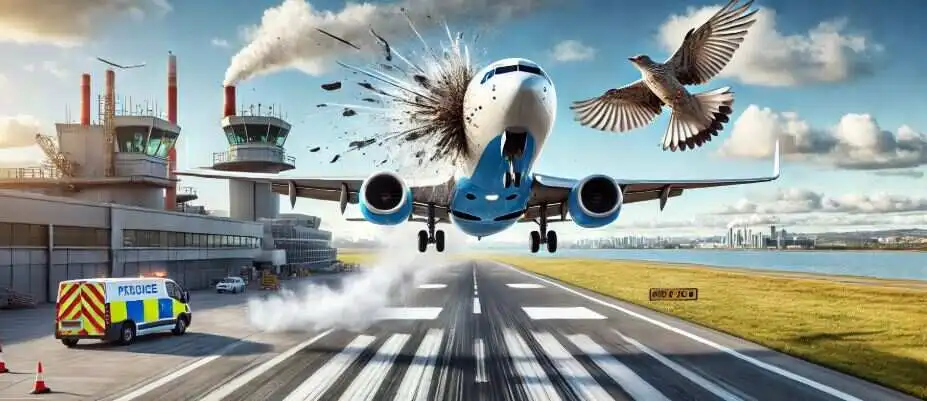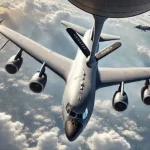Can you picture a tiny 2-kilogram bird causing massive damage to a giant, rigid aircraft or even bringing a powerful, high-speed engine to a halt? Hard to believe, right? Yet, bird strikes are a very real challenge in aviation, with thousands of incidents happening worldwide every year.
These collisions—where birds and aircraft meet, often during critical moments like- approach, takeoff or landing—can lead to serious consequences for both safety and operations. It’s a fascinating intersection of nature and human engineering, highlighting just how unpredictable the skies can be.
This article explores the causes, consequences, and preventive measures surrounding bird strikes, along with notable historical incidents and statistical data.
Why Do Bird Strikes Happen?

Bird strikes occur primarily because both birds and aircraft share the airspace near airports. Airports are often located near bodies of water, grasslands, or other habitats that attract birds. Key factors include:
- Altitude: Most bird strikes happen below 3,000 feet, as this is where birds typically fly. However, strikes have been recorded at altitudes as high as 37,000 feet.
- Time of Day: Strikes are more common during dawn and dusk, when birds are most active.
- Seasonal Migration: Certain times of the year see increased bird activity due to migratory patterns.
Impacts of Bird Strikes

While many bird strikes cause minimal or no damage, some can lead to serious consequences:
- Engine Damage: Ingestion of birds into jet engines can result in compressor stalls or complete engine failure.
- Structural Damage: Bird impacts on windshields, wings, or fuselage can compromise the aircraft’s structural integrity.
- Flight Disruptions: Even minor strikes often require detailed inspections, leading to delays and operational costs.
- Safety Risks: In rare cases, bird strikes can cause emergency landings, jeopardizing passenger and crew safety.
Statistical Data on Bird Strikes
- The Federal Aviation Administration (FAA) reported over 17,000 bird strikes annually in the United States from 2010 to 2022. Approximately 4-6% of this bird strikes damages the aircraft.
- Approximately 65% of bird strikes occur during approach, takeoff or landing, when aircraft are at lower altitudes.
- A study by the International Civil Aviation Organization (ICAO) found that bird strikes cause $1.2 billion in damages globally each year.
- The most frequently struck bird species include gulls, starlings, and pigeons, due to their prevalence near airports.
- While most bird strikes result in no injuries, the FAA has documented less than 20 fatal bird strike-related incidents worldwide in the past 50 years.
Notable Historical Bird Strike Incidents
1. US Airways Flight 1549 (2009)

Perhaps the most famous bird strike incident, this flight encountered a flock of geese shortly after takeoff from New York’s LaGuardia Airport. Both engines were disabled, and Captain Chesley “Sully” Sullenberger executed an emergency landing on the Hudson River. All 155 passengers and crew survived.
2. Eastern Air Lines Flight 375 (1960)

This flight experienced a catastrophic bird strike during takeoff from Boston. A flock of starlings was ingested into three of its four engines, causing a crash that resulted in significant loss of life.
Preventive Measures
The aviation industry employs numerous strategies to reduce bird strike risks, including:
- Wildlife Management: Airports use habitat modification, sound cannons, and falconry to deter birds from residing near runways.
- Technological Innovations: Radar systems can detect bird flocks, allowing air traffic controllers to guide pilots away from potential hazards.
- Aircraft Design: Modern engines and windshields are tested to withstand bird impacts, minimizing damage during collisions.
- Pilot Training: Pilots are trained to handle bird strike scenarios, including engine failures and emergency landings.
How Passengers Can Stay Assured
While bird strikes sound alarming, the aviation industry has made significant advancements in managing these risks. Aircraft undergo rigorous testing, and pilots are highly trained to handle emergencies. Moreover, collaborative efforts between airports, wildlife organizations, and aviation authorities continue to enhance safety.
Conclusion
Bird strikes remind us of the delicate balance between nature and human innovation. By understanding the causes and consequences, and through ongoing preventive measures, the aviation industry strives to make the skies safer for both birds and passengers. Notable incidents serve as lessons that drive advancements, ensuring that bird strikes are managed effectively in the ever-evolving world of aviation.




1 thought on “How Bird Strikes Impact Aviation: The Unexpected Collision!”
Comments are closed.